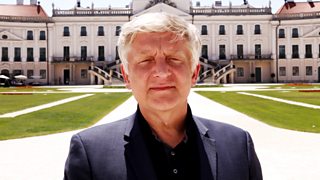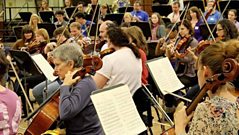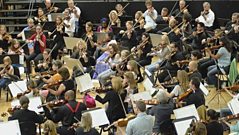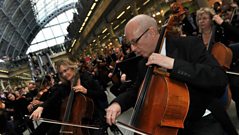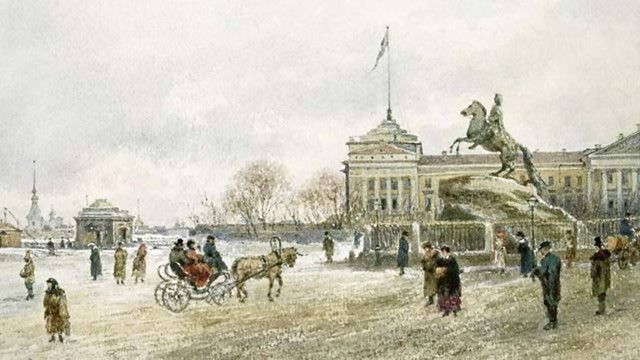
Tchaikovsky - Symphony No. 6 in B minor ('Pathetique')
Vassily Sinaisky conducts the �鶹�� Philharmonic in Tchaikovsky's 6th.
Vassily Sinaisky and the �鶹�� Philharmonic perform Tchaikovsky's Symphony No. 6 in B minor.
“Falling scales subside inconsolably into minor-key blackness above the dying heartbeat of the bass line. For most of his adult life Tchaikovsky was obsessed with death; the nature of Tchaikovsky’s ‘programme’ is easily guessed.”
PYOTR ILYICH TCHAIKOVSKY (1840–93)
Symphony No. 6 in B minor, Op. 74, ‘Pathétique’ (1893)
1 Adagio – Allegro non troppo
2 Allegro con grazia
3 Allegro molto vivace
4 Finale: Adagio lamentoso
Early in 1893 Tchaikovsky returned home to Russia after an extended foreign trip. He was brim-full of ideas, and hugely excited about the symphony he planned to write – it was to be his Sixth. Within four days he had finished the first movement. ‘You cannot imagine what bliss I feel,’ he wrote to his nephew and confidant Vladimir (‘Bob’) Davidov, ‘assured that my time has not yet passed and that I can still work.’ Then followed a teasing half-confession: he had planned the new symphony ‘this time with a programme, but with such a programme that will remain a mystery to everyone – let them guess’. Even with his beloved Bob (to whom he dedicated the work) Tchaikovsky was guarded: ‘The programme itself, whatever it may be, is imbued with subjectivity, and quite often during my wandering, composing it in my mind, I wept terribly.’
Even before these remarks became public, there was intense speculation about the possible ‘meaning’ of the Sixth Symphony. The first performance, on 28 October 1893, was not particularly well received. But then, a few days later, came shocking news: Tchaikovsky was dead – apparently from cholera. The second performance, on 18 November, was a sensation, and immediately the conspiracy theorists set to work. Just look at the symphony’s finale – a catastrophic, ultimately bleak slow movement in the minor key. Surely this had to be a premonition of death? And there, in the first movement, was a quotation from a Russian funeral chant. Had Tchaikovsky foreseen his own end? Could he even have planned it? The story went about that he had been seen drinking unboiled tap water a few days before his death – an almost suicidal act in cholera-infested St Petersburg. Later the rumour grew that it wasn’t cholera at all that had ended Tchaikovsky’s life. He had taken poison, horrified at the prospect of a homosexual relationship with a member of the Royal Family becoming known. The story gathered momentum: Tchaikovsky’s alleged ‘suicide’ wasn’t an entirely voluntary act. He had been ordered to ‘do the decent thing’ by a secret Court of Honour, made up of high-ranking ex-pupils of the composer’s old school.
However attractive these theories may seem, they rest on little evidence and very shaky premises. For one thing, although homosexuality was not generally accepted in Tsarist Russia, above a certain social level it tended to be regarded with much more latitude than in, say, Victorian England. One has only to read Russian newspaper reports of the roughly contemporary trial of Oscar Wilde to find educated Russians reacting with bewilderment to the news that an artist had been persecuted on such a strange pretext.
The truth of the Sixth Symphony’s alleged ‘programme’ is probably a lot less titillating than any of these stories. For most of his adult life Tchaikovsky was obsessed with death. The sight of an elderly or seriously ill human being could throw him into a state of introspective gloom that lasted for days. As that letter of 1893 to Bob Davidov shows, Tchaikovsky was hugely relieved to discover ‘that my time has not yet passed and that I can still work’ – he was only 52! It seems likely that Tchaikovsky had decided to put some of his feelings about death, about the briefness of youth and beauty and the certainty of decay and dissolution, into his new work. But he was also full of plans for the future. In all probability his death that same year was nothing more than coincidence – though it is a coincidence that added enormously to the mystique surrounding his last, and many would say his greatest, symphony.
The Sixth Symphony begins with a truly sepulchral sound: low bassoon against hollow harmonies on double basses and violas. This theme then becomes the springboard for the agitated Allegro that follows. After a while this subsides and a slower, ardent melody (a ‘love’ theme?) emerges on strings, building to a passionate climax. Quieter meditation is violently dismissed by the music of the development, at first all tearing strings and searing brass. Listen out for a brief hymn-like passage led by trombones – this is the quotation from the Russian Orthodox funeral service mentioned above. After a cathartic climax, the ‘love’ theme returns, leading to a quiet, processional coda: more hymn-like wind phrases against a steady tread from pizzicato strings.
After the emotional convulsions of the first movement, the second seems to offer worldly distraction, beginning with a graceful waltz-like tune, its elegance and poise slightly undermined by its being set in five beats to the bar instead of the more natural six. The middle section brings minor-key contrast: a melancholy falling theme (strings) above a throbbing repeated bass. But the opening dance music returns, sweeping on to a radiant climax.
Next the march-like Allegro molto vivace seems to burst into life, but with time one may sense ominous undercurrents – there is something alarming about the hyped-up exhilaration of the ending.
Sure enough, collapse follows in its wake. Many of the Sixth Symphony’s themes follow descending scale patterns. These now find their culmination in the finale’s two main themes. After an unmistakably catastrophic final climax, a quiet gong-stroke heralds the coda: the falling scales subside inconsolably into minor-key blackness above the dying heartbeat of the bass line. Here, at least, the nature of Tchaikovsky’s ‘programme’ is easily guessed.
Programme note © Stephen Johnson
Duration:
This clip is from
Featured in...
![]()
More... Symphony
More highlights from the 'Symphony' season on Radio 3 and �鶹�� Four.
More clips from Symphony
-
![]()
�鶹�� Symphony Orchestra: 'Come and Play'
Duration: 03:07
-
![]()
�鶹�� Symphony Orchestra: 'Come and Play'
Duration: 02:04
-
![]()
�鶹�� Symphony Orchestra 'Come and Play'
Duration: 04:52
-
![]()
Pop-up Symphony
Duration: 03:11
More clips from Afternoon Concert
-
![]()
Charles Ives: The Unanswered Question
Duration: 06:28
-
![]()
Mahler: Adagio, from Symphony No 10 (arr. Castelletti) (excpt)
Duration: 01:43
